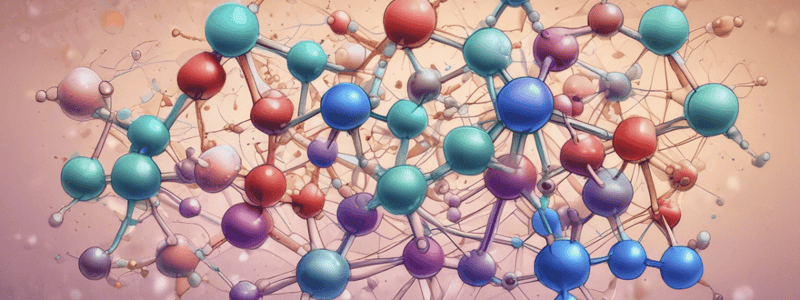Podcast
Questions and Answers
What is the main function of the peptide bond between amino acids?
What is the main function of the peptide bond between amino acids?
- To catalyze enzymatic reactions
- To provide structural importance to the protein
- To form hydrogen bonds with other peptide units (correct)
- To facilitate the transportation of ions and molecules
Which type of glycosylation involves the -NH2 group of asparagine?
Which type of glycosylation involves the -NH2 group of asparagine?
- O-linked glycosylation
- Hydroxylation
- N-linked glycosylation (correct)
- Phosphorylation
Which of the following is NOT a type of non-covalent interaction that maintains the tertiary structure of proteins?
Which of the following is NOT a type of non-covalent interaction that maintains the tertiary structure of proteins?
- Phosphodiester bonds (correct)
- van der Waals interactions
- Ionic interactions
- Hydrogen bonds
What is the name of the secondary structure formed by hydrogen bonds between peptide chains?
What is the name of the secondary structure formed by hydrogen bonds between peptide chains?
What determines the unique conformation of a protein?
What determines the unique conformation of a protein?
What is the characteristic of the side chains in a β-pleated sheet?
What is the characteristic of the side chains in a β-pleated sheet?
Which of the following proteins is an example of a receptor protein?
Which of the following proteins is an example of a receptor protein?
What is the term for the process by which a protein assumes its unique 3D structure?
What is the term for the process by which a protein assumes its unique 3D structure?
Which protein has a quaternary structure consisting of two α-subunits and two β-subunits?
Which protein has a quaternary structure consisting of two α-subunits and two β-subunits?
Which of the following is a consequence of defects in amino acid metabolism and mis-folding?
Which of the following is a consequence of defects in amino acid metabolism and mis-folding?
What is the function of hydrogen bonds in protein structure?
What is the function of hydrogen bonds in protein structure?
Which of the following is NOT a type of non-covalent force that stabilizes protein structure?
Which of the following is NOT a type of non-covalent force that stabilizes protein structure?
What is the term for the covalent bond that forms between two cysteine residues?
What is the term for the covalent bond that forms between two cysteine residues?
What is the name of the helical structure formed by three polypeptide chains?
What is the name of the helical structure formed by three polypeptide chains?
Which of the following proteins is an example of a structural protein?
Which of the following proteins is an example of a structural protein?
Which type of protein has a high percentage of β-sheet structure?
Which type of protein has a high percentage of β-sheet structure?
Which of the following atoms is NOT a hydrogen bond acceptor?
Which of the following atoms is NOT a hydrogen bond acceptor?
What is the approximate distance of a hydrogen bond?
What is the approximate distance of a hydrogen bond?
At physiological pH, which of the following groups is NOT ionised?
At physiological pH, which of the following groups is NOT ionised?
What is the main reason for the existence of Van der Waals forces?
What is the main reason for the existence of Van der Waals forces?
What is the primary reason why hydrophobic regions are unable to form hydrogen bonds?
What is the primary reason why hydrophobic regions are unable to form hydrogen bonds?
Which of the following is a characteristic of Van der Waals forces?
Which of the following is a characteristic of Van der Waals forces?
What is the main driving force for hydrophobic regions of a protein to fold in a specific way?
What is the main driving force for hydrophobic regions of a protein to fold in a specific way?
What determines the final structure and folding pathway of a protein?
What determines the final structure and folding pathway of a protein?
Why are proteins sensitive to denaturation by pH, temperature, and ionic strength?
Why are proteins sensitive to denaturation by pH, temperature, and ionic strength?
What type of bond has a typical energy of 12 kJ mol-1?
What type of bond has a typical energy of 12 kJ mol-1?
What is the significance of the alpha helix and beta-pleated sheet structures?
What is the significance of the alpha helix and beta-pleated sheet structures?
Which of the following side chains is NOT involved in hydrogen bonding?
Which of the following side chains is NOT involved in hydrogen bonding?
Why is protein misfolding a concern in human disease?
Why is protein misfolding a concern in human disease?
What is the relationship between the number of possible protein structures and their functionality?
What is the relationship between the number of possible protein structures and their functionality?
Study Notes
Protein Structure and Function
- Proteins perform various biological functions, including:
- Structural roles (e.g., collagen, keratin)
- Movement (e.g., actin, myosin)
- Enzymatic functions (e.g., trypsin, DNA polymerase)
- Transport (e.g., hemoglobin, transferrin)
- Hormone regulation (e.g., insulin)
- Receptor functions (e.g., acetylcholine receptor)
- Defense mechanisms (e.g., antibodies, clotting factors)
- Gene regulation (e.g., histones)
- Chromosome separation (e.g., tubulin)
Primary Structure
- A polypeptide chain consists of 20 common amino acids
- The first amino acid has an NH3+ group (N-terminal end)
- The last amino acid has a COO- group (C-terminal end)
Secondary Structure
- α-helix:
- Formed by hydrogen bonds between peptide bonds in the same polypeptide chain
- Regular right-handed helix with 3.6 residues per turn
- R groups are on the outside of the helix
- Stabilized by hydrogen bonds
- β-pleated sheet:
- Formed by hydrogen bonds between peptide chains
- Linear peptide chains with side chains alternately above and below the plane of the sheet
Tertiary Structure
- The 3D shape of a polypeptide chain
- Consists of a number of different supersecondary structures (domains)
Quaternary Structure
- The 3D shape of a functional protein formed by multiple subunits
- Examples: hemoglobin (α2β2)
Forces that Stabilize Protein Structure
- Covalent:
- Disulfide bridges (not present in all proteins)
- Non-covalent:
- Hydrogen bonds
- Electrostatic interactions
- Van der Waals forces
- Hydrophobic effect
Hydrogen Bonds
- Formed between two electronegative atoms competing for the same H atom
- H-Bond donors (D): O-H, N-H
- H-Bond acceptors (A): C=O, =N-
Electrostatic Interactions
- Between charged side chains
- At physiological pH, Asp and Glu are ionized, while Lys and Arg are also ionized
Van der Waals Forces
- The sum of attractive or repulsive forces between molecules
- Excludes covalent bonds, hydrogen bonds, and electrostatic interactions
- Dependent on the dipole effect caused by the unequal distribution of electrons
Hydrophobic Effects
- Hydrophobic regions of a protein fold to minimize contact with the aqueous environment
- Hydrophobic regions are unable to form hydrogen bonds
Protein Folding and Stability
- The amount of stabilization energy in a protein is quite small
- Proteins are sensitive to denaturation by pH, temperature, and ionic strength
- Amino acid sequence encodes the final structure and the pathway that leads to that structure
- Misfolding can cause disease
Studying That Suits You
Use AI to generate personalized quizzes and flashcards to suit your learning preferences.
Description
This quiz covers the structures and functions of amino acids, including their side chains and peptide bonds, as well as the importance of hydrogen bonds in biochemistry.




